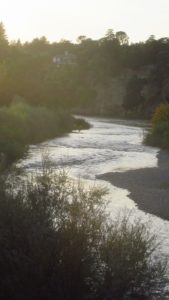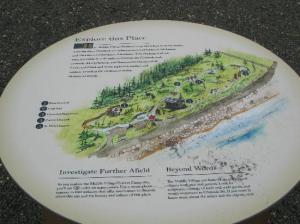Sunday September 10, 2017, 630 am 68 degrees
From my front porch, I watch the orange glow of sunrise above towering trees and behind scattered clouds.
 A tiny bird greeted me this morning, with ‘Ti Too.”
A tiny bird greeted me this morning, with ‘Ti Too.”
I ride to Jim’s Bridge hoping to see a crowd of Canada Geese and ducks engaged in morning rituals and scavenging for breakfast. They hang out on the south side of the riverbank first. Often women come to feed them seeds. When alone, they poke at the rocky shore and swim in shallow water, looking for worms, insects and other morning nibbles.
So few waterfowl are swimming near the Fair Oaks Bridge and nearby boat launch ramp. It is disappointing to visit the bridge and see only boaters. The river today is home to no life beyond that. I remember the Egrets that sat on the north riverbank each morning and the Great Blue Heron that came for an occasional visit. I remember the Egret flying farther east to avoid the Heron as it arrived. I think back to when the Canada Geese and the Mallards fight over food and fight among themselves. Geese hiss and bite. Mallards quack and complain, then chase away who they don’t like.
 I arrive at Jim’s Bridge and all the waterfowl are here! The abandoned Pekin duck has joined the Mallard families. Quack! Quack! Quack! The ducks are quietly waking up, swimming, cleaning, quietly poking their head into the water searching for a morning meal. Occasionally one duck will rant, Quack! Quack! Quack! Quack! Quack! Quack! and no one pays attention. The geese and the ducks are expecting a morning handout.
I arrive at Jim’s Bridge and all the waterfowl are here! The abandoned Pekin duck has joined the Mallard families. Quack! Quack! Quack! The ducks are quietly waking up, swimming, cleaning, quietly poking their head into the water searching for a morning meal. Occasionally one duck will rant, Quack! Quack! Quack! Quack! Quack! Quack! and no one pays attention. The geese and the ducks are expecting a morning handout.
Mallards are so unlike chickens that call out to each other all day long, and call when no one is there to hear. When I hear ducks voice their opinions, no others respond.
In a moment, three ducks rise and fly quietly to the opposite shore. They are too far away and too fast to photograph. Watching them gives me a chance to take a big breath in, feel the chill on my skin. I look up in time to see 20 birds sitting on power lines above the Sunrise Blvd. bridge.
Temperatures are getting warmer already. I ride on to Fair Oaks Bridge. The parking lot for the boat launch ramp is filled with pickup trucks and utility vehicles equipped to tow their boats. I count seven boats in the river, all on the east side of the bridge. I see nearly as many fishermen on the American River as there are ducks.
 A mother duck leaders the way for her two young ducks. They casually swim by boats, leaning trees and those uprooted and fallen into the river. They pause their morning a few moments before moving on. So many birds twitter, unseen. So many times, I see feathers on the ground. I pick them up and wonder how did the birds or the chickens or even an owl lose their feathers? Was it a battle or an argument? Or was losing a feather a natural part of their growth? How do birds lose their feathers?
A mother duck leaders the way for her two young ducks. They casually swim by boats, leaning trees and those uprooted and fallen into the river. They pause their morning a few moments before moving on. So many birds twitter, unseen. So many times, I see feathers on the ground. I pick them up and wonder how did the birds or the chickens or even an owl lose their feathers? Was it a battle or an argument? Or was losing a feather a natural part of their growth? How do birds lose their feathers?
I believe that ducks, geese and birds exercise far more patience than people. People are often in a rush to get anywhere – pack in as much into the day as possible before dropping off to sleep or not even sleep. Waterfowl take their time to swim, to play, and to clean their feathers…and of course, finding food. A duck’s days are for sunning, sleeping, eating, relating to other ducks.
I sit here and wonder what is my role in helping to preserve this peaceful spot where wildlife can thrive?
If more of us sat down to wonder about the miracles of the natural world, would we enjoy more forward thinking environmental concerns and actions? Would more collaborative actions and few disagreements make a bigger difference? I am surprised at how many are just passing through, not noticing the scope of what is here. Envisioning a positive future is rarely a casual visitor’s first thought.
 I enjoy learning the patterns of the morning – the fishermen are always first before dawn! Ducks emerge next. The pigeons arrive flying in their circle dance, then the smaller birds greet me from the top of the bridge. Geese sleep late and most of them arrive long after the ducks have already finished their morning grooming. Egrets keep themselves hidden. It is a gift to see one or two arrive later in the morning.
I enjoy learning the patterns of the morning – the fishermen are always first before dawn! Ducks emerge next. The pigeons arrive flying in their circle dance, then the smaller birds greet me from the top of the bridge. Geese sleep late and most of them arrive long after the ducks have already finished their morning grooming. Egrets keep themselves hidden. It is a gift to see one or two arrive later in the morning. Pigeons circle the bridge. An egret begins its usual lone morning walk along the shore beginning at the boat ramp. While standing at the boat launch ramp, my daughter and I see a goose with a cocked feather. We have seen this one before. We know these geese call this part of the river their home.
Pigeons circle the bridge. An egret begins its usual lone morning walk along the shore beginning at the boat ramp. While standing at the boat launch ramp, my daughter and I see a goose with a cocked feather. We have seen this one before. We know these geese call this part of the river their home.







